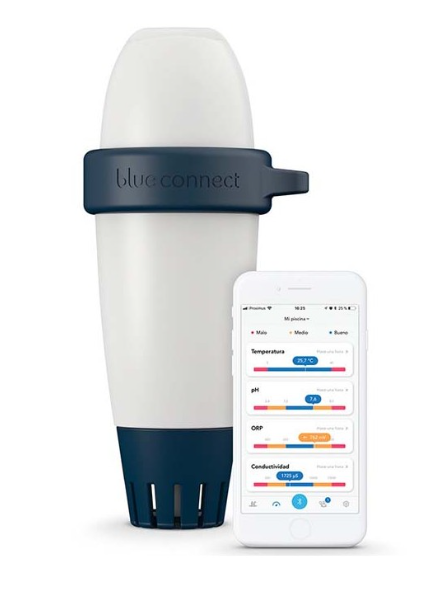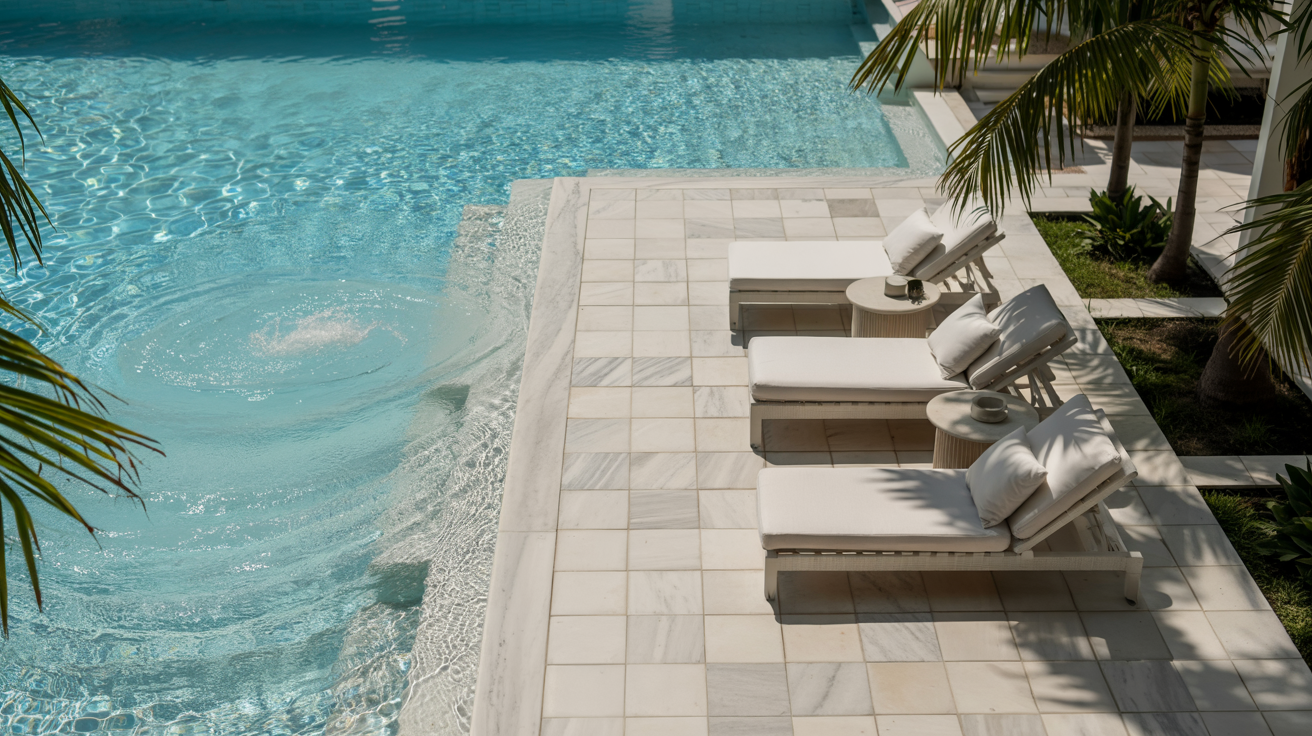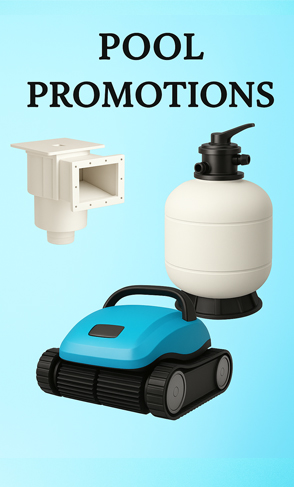White pool water: keys to maintaining healthy water
Having a clean and safe pool is more than just an aesthetic issue. white pool water It indicates proper maintenance and an adequate chemical balance. However, when the colors change and the water becomes cloudy or greenish, these are warning signs that require immediate attention to avoid risks to swimmers' health and damage to the facility.
Water quality depends on factors such as disinfection, pH, alkalinity, and the frequency with which it is filtered and replaced. Maintaining these levels is key to ensuring the water maintains its clarity and prevents unwanted colors that indicate imbalances or contaminants.
How often should the pool water be changed?
Although chemical maintenance reduces the need to drain a pool, water renewal is essential in the long run. A well-treated residential pool can typically maintain its water quality for one to two years without needing a complete drain.
This cycle can be shortened if:
-
There is intensive use of the pool.
-
Chemicals have been applied excessively.
-
The filtration system is not efficient.
-
Water appears with persistent odors or colors.
Furthermore, if errors have been made in product dosage or the water has been invaded by algae or bacteria, it will be more economical and safer to renew the water than to try to restore its quality with more chemicals.
How to know exactly when to change your water with the Blue Connect analyzer
Determining the right time to replace the pool water is not always obvious. However, thanks to devices like the Blue Connect, it is possible to make decisions based on real data and not on visual estimates or intuition.
This analyzer floats on the surface of the water and continuously monitors three key parameters: temperature, pH and ORP. The latter is especially important, as it measures the disinfectant capacity of water. When the ORP falls below certain levels for an extended period, even with chlorine present, it means the water has lost its hygienic effectiveness and should be replaced.

Furthermore, persistent pH imbalances or difficulty correcting them after several treatments may indicate chemically saturated water. Thanks to the real-time notifications offered by the Blue Connect app, these anomalies can be detected without waiting for the water to change color or become cloudy.
The system itself, based on Riot Labs technology, advises you on when it's best to act to keep your pool healthy. If levels remain unstable even after several corrections, the device recommends partial or complete water replacement, thus optimizing product consumption and prolonging the life of the filtration systems.
Cloudy pool water: causes and effects
One of the most common problems is the cloudy pool water, which may be due to suspended particles, pH imbalance or poor filtration. This cloudiness often occurs after a rainstorm, a mass swim, or improper chlorination.
The main concern with cloudy water is the proliferation of microorganisms. Water that isn't completely clear makes it difficult to see the bottom, which can cause accidents or make it difficult to rescue someone in an emergency.
In addition, turbidity encourages the growth of bacteria and algae, so swimming in these conditions is not recommended until the problem is resolved.
Green pool water: the sign of an algae invasion
When the water changes to a greenish color, this is a clear sign of the presence of algae. green pool water It occurs when chlorine levels are insufficient or the filtration system is not working properly.
Algae reproduce rapidly, especially if the pool is exposed to direct sunlight. In addition to changing the color of the water, algae can adhere to the walls and bottom, making the surface slippery and dangerous.
Removing algae involves:
-
Brush the walls and bottom.
-
Perform shock chlorination.
-
Keep the filtration system running continuously until transparency is restored.
-
Vacuum up waste after treatment.
Saltwater pool water: a sustainable alternative
The saline chlorination system is increasingly present in modern swimming pools. salt pool water It contains dissolved salt that, through electrolysis, is converted into chlorine to continuously disinfect the water.
This type of water isn't "salty" like sea water, as the salt concentration is low, but sufficient to generate chlorine without the need for additional products. It also prevents the eye and skin irritation caused by traditional chlorine.
Maintenance remains key, as it can become cloudy or greenish if salt, pH, and stabilizer levels are not controlled.
Cloudy whitish pool water step-by-step solution
One of the most disconcerting phenomena for many homeowners is the cloudy whitish pool water solution. This problem may be due to:
-
Overdose of chemicals.
-
High presence of lime in the water.
-
Insufficient or incorrect filtration.
To fix it:
-
Check and adjust pH levels (ideally between 7.2 and 7.6).
-
Add flocculant to clump together fine particles.
-
Leave the filtration system on for at least 24 hours.
-
Carefully vacuum the bottom once the impurities have been decanted.
It is important to avoid bathing while doing this process, as the chemicals can be irritating if left unchecked.

How to clarify pool water in different situations
For clarify pool water Depending on their color and cause, specific strategies should be followed that include both physical cleaning and chemical adjustment. Not all solutions are universal, so it's essential to identify the source of the problem.
Clarify cloudy water
If the water is cloudy but has no defined color, the process includes:
-
Cleaning the filter.
-
Checking for free chlorine (should be between 1 and 3 ppm).
-
Application of clarifier or flocculant.
-
Continuous filtration for at least 24 hours.
Clarify green water
In case of green water, the priority is to eliminate algae:
-
Shock chlorination with specific products.
-
Complete cleaning of walls and bottom.
-
Check and adjust pH.
-
Aspirate after 48 hours of filtration.
Clarify whitish water
When the water has a cloudy white color, it is recommended:
-
Check calcium hardness.
-
Use anti-limescale products if there is excess minerals.
-
Do not use incompatible products, such as chlorine and algaecide, at the same time.
The color of water as an indicator of health
The water should be crystal clear and slightly blue due to the reflection of the sky. Any other shade is a warning. Transparency is the best indicator that the chemical levels are balanced and that the filtration system is working properly.
When water turns white, green, or cloudy, it's important to act immediately to avoid structural damage, increased costs, and health risks.
Keeping your pool in ideal condition is in your hands.
A clean pool doesn't just depend on appearance, but also on chemistry and consistent maintenance. Knowing what each water color means and how to clarify pool water Depending on the problem, this can help avoid major complications. Check the levels periodically, clean the filters, and respond to any changes in the water's appearance.
Don't wait for your pool to give warning signs. Apply the right solutions and enjoy safe swimming every day.












Leave a comment